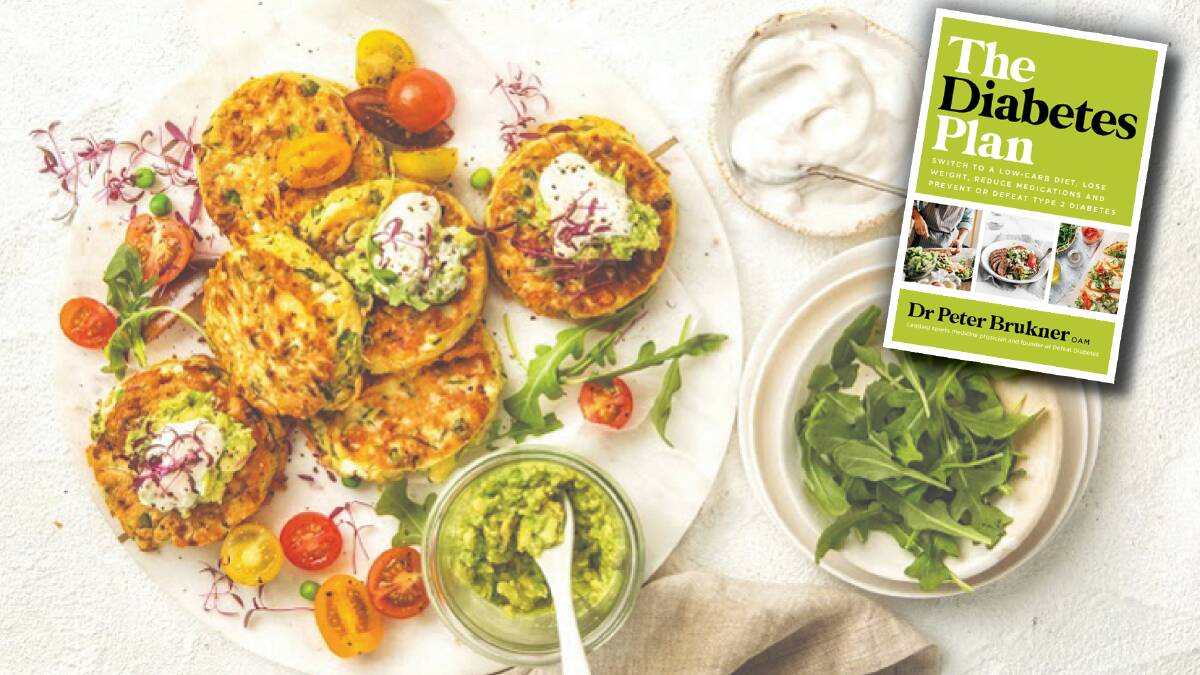
At age 60, Dr Peter Brukner was diagnosed with pre-diabetes, despite having followed the dietary advice of his own profession all of his adult life.
Subscribe now for unlimited access.
$0/
(min cost $0)
or signup to continue reading
Intrigued, Brukner did a deep dive into the research, and quickly reversed his dietary practices, ditching high-carb, low-fat for low-carb, high-fat.
He lost 13 kilograms and dramatically improved his metabolic health. To help others achieve remission, he created an online program, Defeat Diabetes, which has seen thousands of Australians lose weight and reverse type 2 diabetes.
Here he dispels some common myths about low-carb, high-fat diets.
1. Low-carb diets work, but are not sustainable long-term
Low-carb diets are sustainable in the long-term because eating plenty of healthy fats and proteins means you are not hungry. Hunger is the main reason other diets are not sustainable.
2. Most of the weight lost on low-carb diets comes from water weight
When you start a low-carb diet and lower your insulin levels, water and salt are lost from the kidneys. However, the body rapidly adapts and subsequent weight loss is due to loss of body fat.
3. A low-carb diet will cause clogged arteries and heart attacks because it is too high in saturated fat
It has been shown in numerous scientific studies that saturated fat from animal sources such as dairy, meat and eggs has no correlation with atherosclerosis and heart disease. This is a long-standing myth with no evidence to support it.

4. The brain needs carbs to function properly
The brain needs a small amount of glucose, which can be produced from fats and proteins by a process known as gluconeogenesis. The brain functions very well using fats, in the form of ketone bodies, as its main fuel source.
5. Ketosis is dangerous and damages the kidneys
There is no evidence of kidney dysfunction on a ketogenic diet. Persistently elevated blood sugar levels damage the kidneys, so maintaining blood glucose levels within normal range on a low-carb diet can help prevent kidney disease.
6. Low-carb diets suck calcium from your bones
There is no evidence that low-carb diets remove calcium from bones. In fact, low-carb diets have been shown to improve bone density in those with osteoporosis.
7. Eating meat is bad for the environment
The debate between meat vs plant diets and their impact on the environment fails to recognise the complexity of food systems. Industrialised agriculture (both plant crops and animal feedlots) is harmful to the land, soil, water and climate. Sustainable farming practices that renew soils and tackle climate change include regenerative farming and pasture-fed animals.
8. I need to eat carbs to manage my diabetes
Diabetes is a disease of carbohydrate intolerance, so controlling carbs will help to bring blood glucose levels under control. Low-carb diets have been proven to be effective in managing diabetes.
9. You need carbs for energy
The human body has two potential fuel sources for energy - carbs and fats. The body is capable of using either as its primary source.
10. Low-carb causes nutrient deficiencies
With a focus on real foods such as meat, fish, eggs, dairy, vegetables, nuts and seeds, your diet will be nutrient-dense. In contrast, diets full of empty calories such as junk foods, processed foods and refined grains are more likely to be nutrient-deficient.
11. Low-carb diets can lead to depression
Low-carb diets have not been shown to be associated with depression. On the contrary, there has been some interesting research from Deakin University showing improvements in depression and anxiety from a real food diet.
12. Low-carb could cause ketoacidosis
The levels of ketones associated with a low-carb or ketogenic diet are well below the levels associated with ketoacidosis. The only exception is in those patients taking SGLT2 inhibitors, which should be discontinued when commencing a low-carb diet.
13. Low-carb is too expensive
Like any diet, it is possible to select budget-friendly options. Additionally, hunger comes under control with this way of eating, and many people find themselves eating fewer snacks, eating two instead of three meals a day and eliminating discretionary food purchases, such as cake and confectionery.
14. A low-carb diet has way too much protein in it
Low-carb diets are not high-protein diets. Recommended protein intake is in line with other types of diets.
15. Low-carb will harm your liver
Low-carb diet will improve your liver function and can reverse the condition known as non-alcoholic fatty liver disease (NAFLD).
- The Diabetes Plan: Switch to low-carb, lose weight, reduce medications and prevent or defeat type 2 diabetes, by Dr Peter Brukner. Macmillan. $36.99.
- defeatdiabetes.com.au
15-Minute Mexican burrito bowl
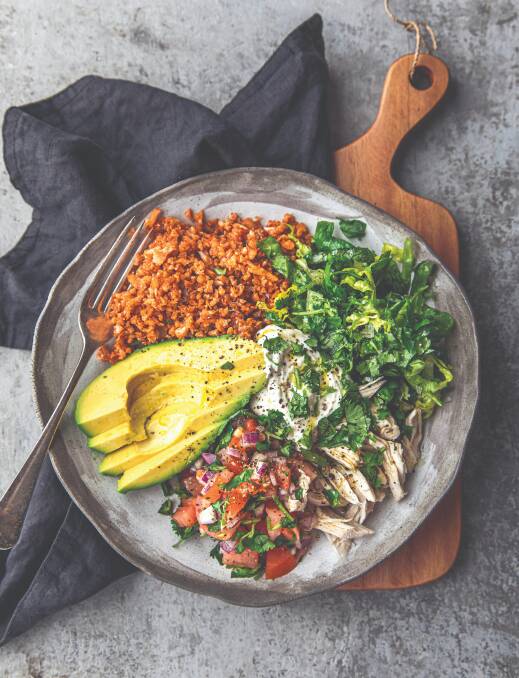
A healthier alternative to a takeaway burrito, this recipe contains all the delicious Mexican flavours everyone loves, but with fewer carbohydrates. Paprika contains antioxidant properties, which may help reduce the risk of cancer and heart disease, improve immunity and even alleviate gas. Handy!
Ingredients
1 tomato, roughly diced
1/4 red onion, finely sliced
1/4 cup coriander, roughly chopped, plus extra to serve
1 tbsp olive oil
salt and pepper
3 cups cauliflower florets, grated
1 tsp paprika
1/2 head cos lettuce, shredded
300g cooked chicken breast (or boneless barbecued chicken), shredded
1/2 avocado, sliced
2 tbsp unsweetened full-fat Greek yogurt or sour cream
Method
1. In a small bowl, combine the tomato, red onion and coriander. Add one teaspoon of the olive oil and season with salt and pepper. Toss to combine and set aside.
2. Heat the remaining olive oil in a small frying pan over medium heat. Add the grated cauliflower and paprika, season with salt and pepper and cook, stirring occasionally, for five minutes or until golden brown.
3. Divide the cauliflower between two bowls and add the shredded lettuce, chicken and tomato mixture. Top with the avocado and Greek yogurt, sprinkle with extra coriander and serve.
Tips: This meal tastes great with cold or hot chicken. If you are eating straight away, you can reheat the chicken by tossing it in the pan after you've removed the cauliflower.
If you are preparing this to take to work, keep the chicken and cauliflower in one container and the remaining ingredients in another container. This way you can reheat the chicken and cauliflower in the microwave. Ping!
Serves 2.
Per serve: Protein: 53.6g. Fat: 21.1g. Net carbs: 19.8g. Fibre: 9.5g.
Easy sausage tray bake
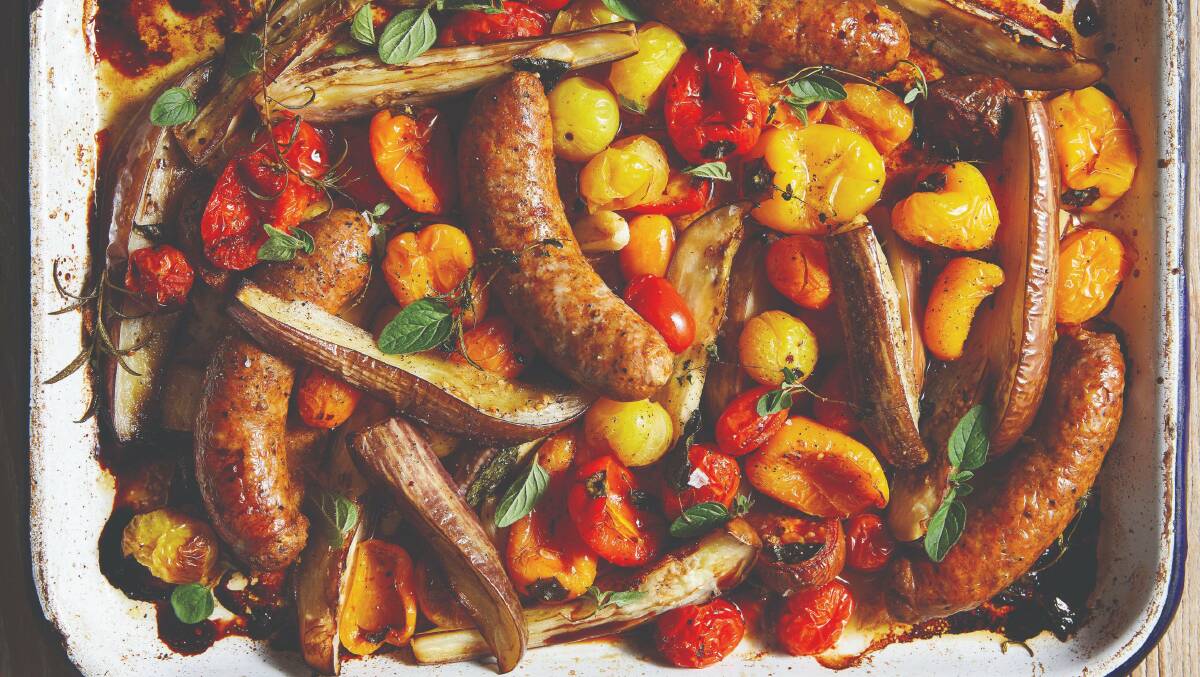
There's no need to overcomplicate cooking. Sometimes all you want is no-fuss comfort food that looks as good as it tastes. This dish ticks all of those boxes and more - simply assemble the ingredients on one tray and bake. What could be easier?
Ingredients
200g mixed cherry tomatoes
1 medium eggplant, cut lengthways into 8 wedges
80g mini capsicums
2 garlic cloves, smashed
few sprigs thyme, rosemary and oregano
2 good-quality sausages
1 tbsp grass-fed ghee, melted
2 tsp balsamic vinegar
salt and pepper
Method
1. Preheat the oven to 180C fan-forced.
2. Place the tomatoes, eggplant, capsicums, garlic, herbs and sausages in a single layer on a large baking tray.
3. Drizzle with the melted ghee and balsamic vinegar, and season with salt and pepper. Toss together to coat.
4. Transfer the tray to the oven and cook for 30 minutes, turning the sausages halfway through the cooking time.
5. Serve immediately.
Tips: We recommend buying your sausages from the butcher and having a chat about what goes into them. Sausages from the supermarket commonly have bread and other fillers, so be sure to find ones that are made with just the good stuff! Look for sausages made with 100 per cent meat to keep the carbs down.
Olive oil can be used instead of ghee, if preferred.
Serves 2.
Per serve: Protein: 13.2g. Fat: 20.6g. Net carbs: 14.9g. Fibre: 10.6g.
Silky salmon curry
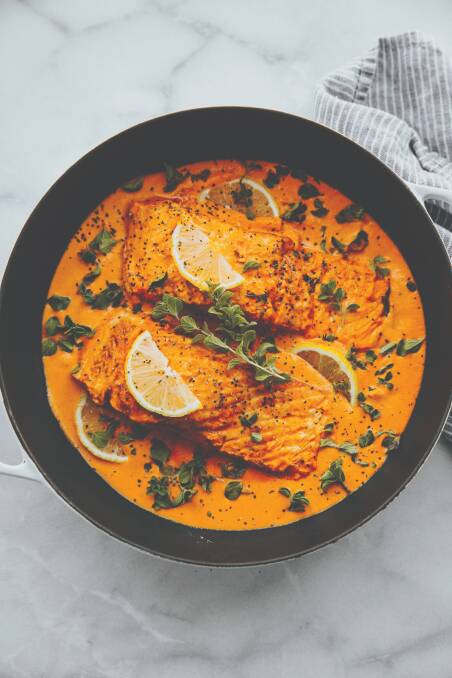
This sweet and sour curry has a tangy sauce we know you'll love. Salmon is such a great protein source, full of omega-3. Our Defeat Diabetes expert dietitian Nicole Moore can't get enough of this dish - and neither will you, thanks to its rich, vibrant Thai-inspired flavours.
Ingredients
2 tbsp olive oil
2 tsp curry powder
2 tsp Thai red curry paste
2 garlic cloves, minced
2 tbsp tomato paste
400g skinless salmon fillet
salt and pepper
1 cup coconut milk
Method
1. Heat the olive oil in a frying pan over medium-high heat. Add the curry powder and cook, stirring, for one minute, until fragrant. Add the red curry paste, garlic and tomato paste and cook for one minute.
2. Season the salmon with salt and pepper and add it to the pan, turning to coat in the sauce.
3. Reduce the heat to medium and cook the salmon for four minutes, then flip and cook for a further three minutes. Finally, add the coconut milk and cook for a further five minutes, until the sauce has reduced slightly, then serve.
Serves 2.
Per serve: Protein: 41g. Fat: 29g. Net carbs: 4.2g. Fibre: 2.2g.
Zucchini and feta fritters
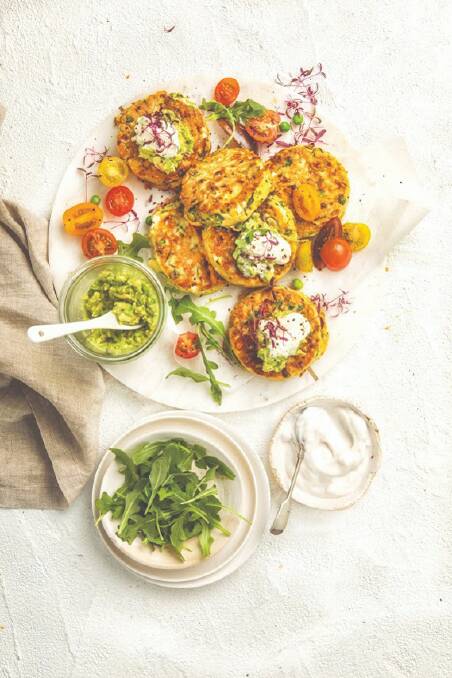
These veggie fritters are super easy to make and perfect for brekkie or lunch. Peas are pretty much off the menu for a low-carb diet but this fritter recipe uses a tiny amount to satisfy your cravings.
Ingredients
1 medium zucchini
1/2 cup Greek goat's feta, crumbled
1/2 spring onion, sliced
1/2 cup fresh or frozen peas
2 large free-range eggs, whisked
1/2 cup almond meal
zest of 1 lemon
salt and pepper
1 tbsp olive oil
Yogurt dressing:
1/4 cup unsweetened full-fat Greek-style yoghurt
juice of 1/2 lemon
salt and pepper
Method
1. To make the yogurt dressing, combine the yogurt and lemon juice in a bowl. Season with salt and pepper to taste and set aside.
2. Grate the zucchini into a bowl and add the feta, spring onion, peas and egg. Add the almond meal, lemon zest and salt and pepper to taste, and fold to combine.
3. Heat the olive oil in a large frying pan over medium heat. Shape the zucchini mixture into four equal-sized patties and pan-fry for three to five minutes each side, until golden and cooked through.
4. Divide the fritters between two plates, drizzle the yogurt dressing over the top and serve.
Tip: Make the fritters the night before and simply reheat in an air-fryer or microwave for a quick brekkie or lunch.
Serves 2.


